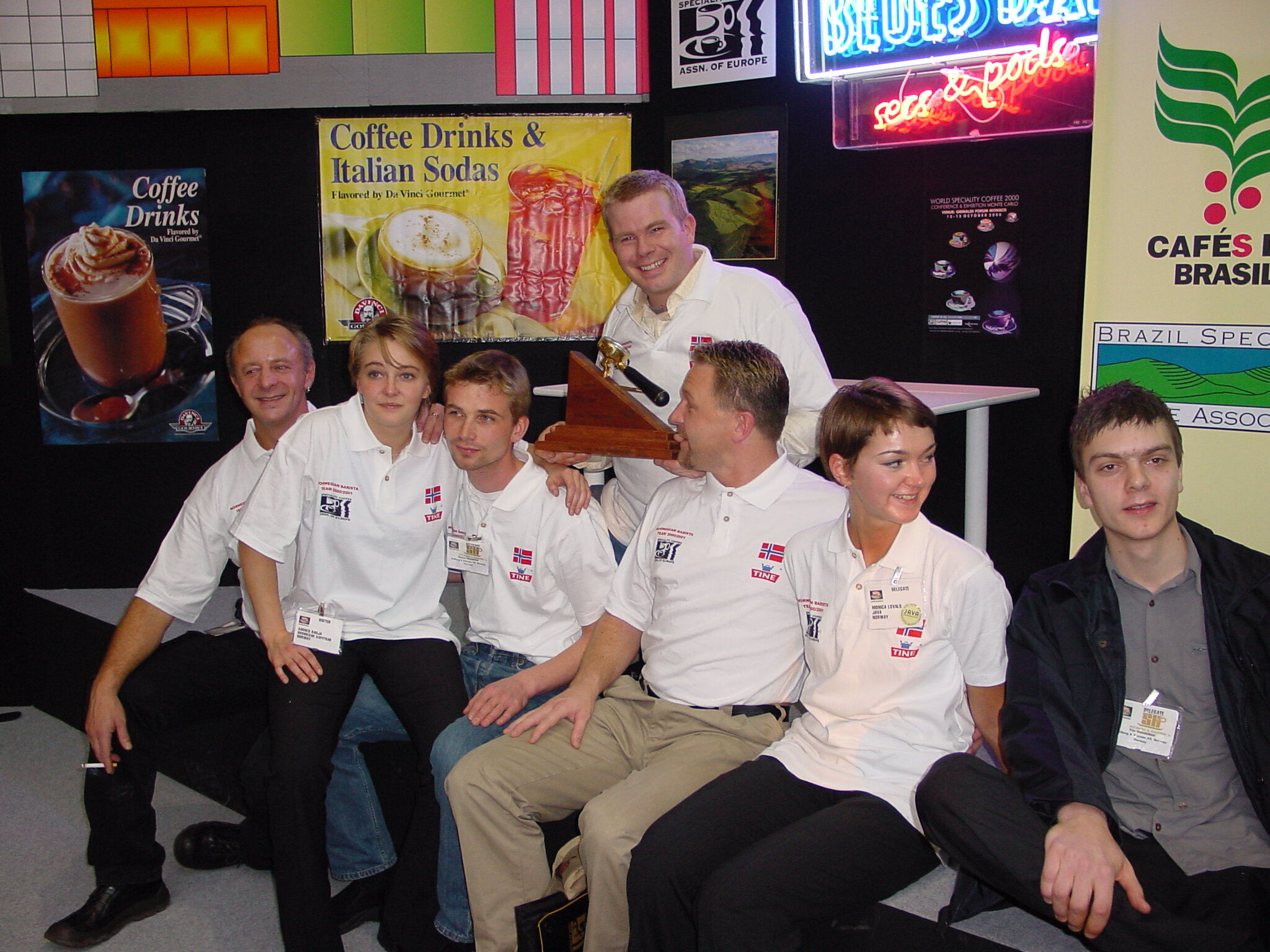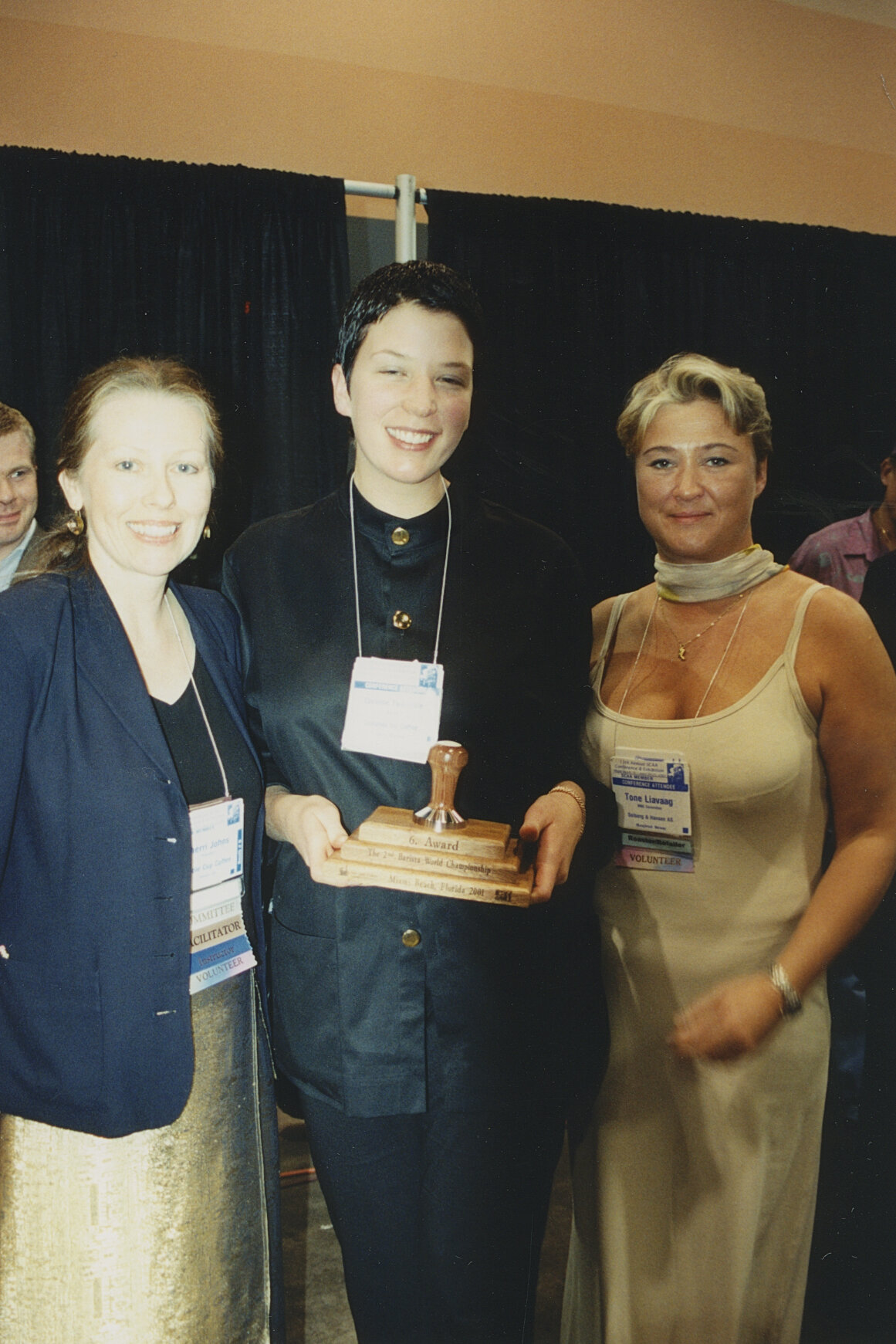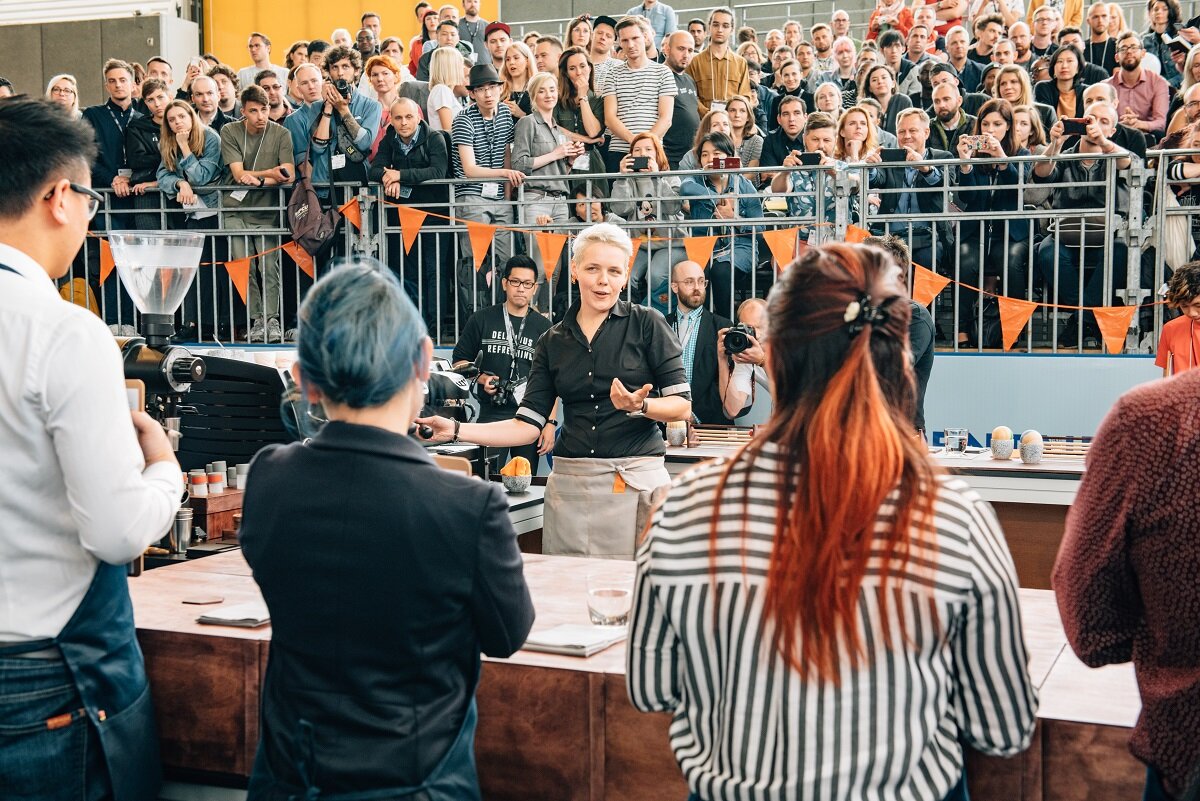Calling the Shots: 20 Years of the World Barista Championship - 25 Magazine, Issue 9
This year, South Korea's Jooyeon Jeon was crowned the 20th World Barista Champion at the World Coffee Championships in Boston.
KELSEY KUDAK traces the evolution of the global competition and its impact on the specialty coffee industry over the past 20 years. [Editor’s note: After going to print, we regrettably noted a photo caption omitting the presence of Sherri Johns, US Barista Championship co-organizer, WBC Miami co-organizer, and past Head Judge. The caption has been corrected here.]
Last year, Agnieszka Rojewska, who was the first woman to win the World Barista Championship (WBC), used an Ethiopian coffee to journey back to her first visits to cafés. She mused upon the epiphanies of specialty coffee: the ways in which it subverts expectations; how milk makes espresso approachable; and the joy found in a sip of espresso when it’s shared.
What began as a small gathering to advance the prestige and respect of some 17 career baristas in a small corner of a convention center in Monte Carlo has morphed into a global arena with 62 competing countries and Olympic style pomp. The competition has all its variability, too: Will it be a perfect day, or will the coffee taste differently than the competitor thought?
The judges are seeking a champion who has “mastery of technique and craft” and is “passionate about the barista profession.” But champions must also have a broad understanding of coffee knowledge beyond their performances, as they become superheroes of sorts, serving as “role models” and sources of “inspiration” for others. The standards are high and coffee remains ephemeral, even with all the technical controls of today. Now, in its 20th year, the WBC remains both a vehicle for and reflection of the day’s trends in coffee technology, cultures, and networks. What was once seen as a silly contest is now a 15-minute platform that undeniably changes lives. Year after year, the WBC broadens our understanding of the current landscape of coffee, and pushes the boundaries of what coffee can be.
***
In 2000, the WBC was almost nothing like it is today. Because the sponsored machine only had two group heads and came with only one single and one double portafilter, competitors created nine drinks for three judges. For spectators’ ease, espresso machines were fitted with mirrors above them to reflect what was happening atop the small tables clothed in banquet skirts, while baristas worked with their backs to the judges. Judges scored both the technical and sensory, whose original standards were derived from horseback riding and gymnastics, and assigned scores to whether the baristas were “familiar” with the machine, checked the grind, and “appeared confident” when “frothing milk.” (More dubious criteria included “Does the barista run the espresso to the taste of the blend?”) En lieu of latte art, milk drinks were etched or piled high with foam, and shots were tamped with anything from steel to plastic to aluminum. The MC interjected mid-pour, and judges were allowed to ask what baristas were doing while they were doing it. The audience roared, and baristas donned sponsored logos. It was a sporting event in its truest sense.
For spectators’ ease, mirrors were fitted above the espresso machines (Miami, 2001).
Robert William Thoresen, who won the first championship, still attributes the win to his work ethic and detail-oriented personality. Robert drew on his experiences at bars to bring the elements of hospitality to his guests, both in competition and at his Oslo shop.
Robert Thoresen and his team pose for a photo after Robert was crowned the first-ever World Barista Champion in Monte Carlo (2000).
Robert’s competition preparations were ahead of their time: He scoured the just-budding coffee forums for information on grind, coffee blends, and “steaming” technique. He remembered being the only competitor to bring his own grinder and milk, and poured latte art, separating himself from the trend of milk-foam mountains and homemade syrups. His conceptual signature beverage was meant to emulate the experience of eating a chocolate truffle: he cooled espresso with dry ice to prevent dilution, and because there were no rules about signature beverage volume, served it in the divot of a coffee saucer, offsetting the espresso with an island of cream he’d shaken in a bar tin. The judges then brought the bittersweet drink to their faces in the way his grandparents drank coffee after a meal in Norway.
***
With each year, the competition formalized and competitors from new regions of the world partook, which resulted in clearer rules. Milk was defined as “cow’s”; judges were forbidden from eating on stage or taking smoke breaks between competitors; competitors were forbidden from putting chiles and ginger and anything other than coffee in portafilters, and eventually no longer required to set sugar on the table for the judges. But, to foster impartiality, the competition would also require judges to be calibrated, come from a wider pool, and rotate during the day, rather than use a spittoon on stage to avoid over-caffeinating.
Co-organizer Sherri Johns (left), competitor Corinne Tweedale of Australia (center), and co-organizer Tone Elin Liavaag (right) at the 2001 WBC in Miami.
The first judges’ calibration was held in Boston in 2003, and also marked the use of 2 double portafilters and the current format of 12 drinks and 4 sensory judges. Twenty-one judges from 14 countries took a written test of 40 questions about coffee knowledge and behavior on stage, and all of them were certified. The following year, in Trieste, judging applicants grew to 94, of which 64 were accepted, 25 were certified, and 14 were utilized in competition. A single-day judges’ workshop included practical training on six espresso machines, with former finalists and champions at each station for guidance.
From 2004, relativity continued to be pared down from scoresheets. Phrases like “Does the barista seem to enjoy what (s) he is doing?” were omitted, and arguments about what it meant to “tamp correctly” were quelled. The rules homogenized technique and streamlined competition objectives while allowing space for cultural differences. Scoring language was changed from “very good” or “very bad” to “acceptable” or “unacceptable.”
In 2007, the WBC saw an even larger shift when the competition moved to Tokyo, welcoming both a broader scope of competitors and an onslaught of innovation. It was also the first year the competition was broadcast live, which is to say two volunteers uploaded videos of competitors to YouTube in real time, which was a larger reflection of coffee conversations shifting to global platforms like Twitter and other forms of social media.
Miyuki Miyamae, representing Japan, just before beginning her performance at the 2007 WBC in Tokyo. Photo: Emily Oak.
James Hoffman from the United Kingdom won the 2007 competition with two, single-estate coffees from Costa Rica and Kenya, kicking off yet another new trend and a larger discussion of value-chain narrative. The move was upheld by the standardization of sensory judging; judges were now meant to assign scores based on the flavor notes given to them, rather than their preferences. So while Hoffman admitted the note of black currant in his espresso was “unusual” and “different,” the judges were precluded from docking points, as long as that note, as well as the tobacco foam of his specialty beverage, matched what he was saying.
The internet had also helped advance these single-origin narratives, which were popularizing cafés. Previously, said Emily Oak, long-time judge and former Australian WBC competitor, “When you wanted information about a coffee, you sent a fax to the mill and someone drove it up the road, and the farmer wrote notes.” But as Skype and visits to origin became commonplace, producers’ narratives became a necessary part of competition. With this quickened exchange of information, participants began to better understand their coffees through altitude, soil, and processing techniques, and competition trends met this pace. That year also marked the first woman to infiltrate the top three in WBC history: Heather Perry from the United States, currently the SCA President, placed second.
In 2011, another monumental shift occurred with the formation of World Coffee Events (WCE). Its objective was to standardize competition globally, including national competitions, so the WCE focused on extending its cohort of well-calibrated, international judges. By 2013, the organization had certified 250 judges who passed tests in sensory skills, written skills, barista skills, and practical skills. The WCE also established two committees: Competition Strategies, which would interface with the then SCAE Board of Directors, and the Rules and Regulations Committee which would work with experts to ensure the competition retained its esteem.
***
Practically, the WBC has functioned as a means for baristas to fine-tune their skills. Because it forces competitors to break down each step of what they’re doing and the reasons behind it, the competition format has also become a training tool for new baristas in many cafés. During competition season, competitors learn a coffee so well, they’ll know how it will taste just from the way it’s falling from the basket. They’ve unearthed its best roast date, having cupped it and worked with it across the days and weeks of its aging. They’ll know how it’s been grown, picked, processed, and roasted, and if they’re really excellent, they’ll be telling their own story parallel to their coffee’s: a narrative of hospitality that is universal, perceptive, and innovative.
But winning doesn’t simply come from guts and sheer talent. As Icelandic veteran judge and organizer Sonja Björk Grant put it, “The ability to identify a barista as having the potential to be the World Barista Champion is one percent. Their support system, discipline, opportunity, and family are the rest of it.”
There are other factors that complicate this notion: money, which can sometimes exclude competitors from participating, and language (Agnieszka, who is Polish, won last year’s competition in her second language). Though the rules allow competitors to bring a translator to competition, they must pay for that interpreter to attend, and, as Sonja noted, it can sometimes be a roadblock. The translator can’t interpret the “fire in your eyes” to the judges. Though latter years of competition have brought more competitors from major producing countries to the stage (Alejandro Méndez from El Salvador and Raúl Rodas from Guatemala won the title in 2011 and 2012 respectively), a competitor from an African country of origin has yet to make it to the final round of competition.
Agnieszka serves the judges during the finals round of the 2018 World Barista Championship in Amsterdam.
Even as the competition has entered its arguably most technical era, there is still space for growth. The winner earns a platform for both their craft and their industry, which is an incredible responsibility taking up much of the coming year. Many were quick to name possible focuses of that platform: For Sonja, sustainability and climate change could be brought to the forefront; Robert sees a larger opportunity to elevate coffee’s market price through the education of guests in the café: Why should a lacto-fermented coffee cost as much as a glass of wine? What’s the difference between a Gesha and a Cattura, or a natural versus a honey?
“Coffee is evolving fast,” said Agnieszka, during her presentation in 2018. “What was new yesterday is basically a standard today. Which is [a] good and exciting thing. But at some point, it got me thinking: Where are we heading? Where is the future for specialty coffee?”
KELSEY KUDAK is a New York City-based journalist focused on coffee writing and immigration stories. She holds an MA in Narrative Journalism from New York University, and has written for the New York Times, New York Magazine, Standart, and an assortment of other publications.
Research for #WBC20Years generously supported by Victoria Arduino and Urnex. To see and share memories of the WBC as it celebrates its 20th year, visit wcc.coffee/WBC20Years.






